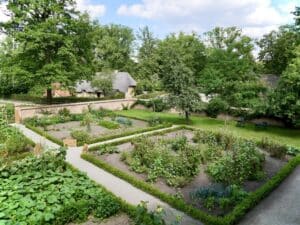A Guide to Ornamental Grasses

Ornamental Grasses have become increasingly popular in Australian gardens. Their unique textures and shapes can bring elegance and sophistication into your garden design, and they’re an easy and low-maintenance plant species that any gardener can grow at home.
We’ve put together this comprehensive guide to help you incorporate these amazing plants into your own garden. We’ll talk about the best ways to use these plants in your landscape design and how to cultivate the right conditions for them to grow and flourish.
Grasses and Strap Leaf Plants
Before we begin, it’s also worth familiarising yourself with another term: strap leaf or ‘strappy’ plants. These plants have long, thin strap-like leaves that grow together in clumps. While their growth habit is highly similar to grass, they typically lack the hollow ‘culm’ stems of a true grass species (although ‘sedges’, a variety of strappy plant, also have culm stems.)
Many of the most popular ornamental grasses, including Lomandra, Dianella and Carex, are technically not grasses and are actually strap-leaf plants. However, this botanical distinction is more scientific than anything else – Lomandra is even popularly named ‘Basket Grass’.
Because their growth habits and care instructions are so similar, most gardening stores will group grasses and strap leaf plants together – including in our own Diacos Online Store.
Meanwhile, all of the general landscaping & care advice discussed in this guide can also be easily applied to most of the popular strappy plants available for home gardening.
Using Ornamental Grasses in Your Garden Design
While you might not expect grass to have the ‘wow’ factor of trees or exotic flowers, it’s quite common to hear gardeners refer to these plants as the ‘quiet achievers’ or ‘unsung heroes’ of garden landscaping, and there are plenty of very good reasons for this!
Well-placed grasses can add elegance, flow, and form to your garden in ways both subtle and striking. There are a lot of clever options for incorporating these plants into your garden design, and they can be especially useful for filling the tight and tricky spots in your yard.
Below, we’ll talk about some of our favourite creative ways to use ornamental grasses:
Borders and Edging
Grasses are a perfect border plant, as their versatile nature makes them easy to plant in tight spaces and alongside most other plants. Their clumps of thin, delicate leaves will work to soften harder edges like fencelines or stone paths. Planting beautiful flowering grasses like Kangaroo Paw or Liriope Monroe will create walls of colour during the blooming season.
Shorter grasses can make neat & attractive borders around areas like patios, paths or garden beds, while longer grasses are highly effective when planted as privacy screens. There are a dizzying array of colours to choose from, even when selecting non-flowering grasses, from deep reds and purples to lush greens and shimmering golds.
Creating Movement and Flow
Ornamental grasses can add a lot of drama to the garden as the wind gently tussles their many leaves. Longer grass plants like Fountain Grass or Lomandra Longifolia will dance and sway on the breeze, bringing a calming sense of movement and flow to your garden.
This calming effect can work particularly well when incorporated with Asian Zen Garden elements like water features, boulders or pebbles or a central ornamental tree. When placed right, they can influence visual flow by cleverly directing the eye around the garden.
Backgrounds and Foregrounds
Grasses can also make spectacular backdrops or foregrounds for other displays. While planting grass as an edge or boundary is more about creating structure and definition, this technique is all about experimenting with different textures, colours and contrasting shades to create interesting, multilayered garden displays.
The neutral tones and dense soft foliage of grasses tend to complement most other garden plants particularly well, and there is an opportunity here to go as far as your imagination can take you. For instance, the dense linear lines of a flowering grass like Agapanthus can have interesting visual effects, drawing the eye to the area and clearly highlighting the foreground.
Don’t be afraid to mix multiple different grass types or try out unique and creative layouts, as you’d be surprised at how well it can all come together! Some grasses, like Phormium, have a wide range of differently coloured variants available to choose from.
Planting Practical
Grass adds more than just visual appeal to a garden, and its many practical properties are part of the reason it has become such a popular choice for gardeners. As mentioned, the general hardiness of these plants allows them to grow in tight spots, and they’re a highly effective ground cover for suppressing weed growth. They grow fast and are hard to kill.
Their dense root systems are also beneficial to the soil, which is something we’ll talk about later in a bit more detail. Finally, flowering native grasses like Acacia Cognata, Kangaroo Paw or even Pennisetum Rubrum (Fountain Grass) are especially appealing to wildlife.
Even just a small amount of Australian grass in your yard will attract beautiful native birdlife and beneficial native pollinators to your garden. What’s not to love about that!
Caring for Ornamental Grass
As well as their aesthetic appeal, these plants also have a great reputation for being low-maintenance and easy to look after. If you want to grow a garden that isn’t going to take too much time and energy to maintain, planting Ornamental Grass is a fantastic option.
Grasses tend to originate from arid deserts, steppes or plains environments, where drought conditions are common and soil is poor. This is especially true of Native Australian grasses and strappy plants, which are very popular in Melbourne and make up a large selection of our range at Diacos. Most can generally be planted at any time of the year.
Still, every plant is unique and it’s always worth checking the care instructions for your specific plant. Grasses from other climate zones may potentially have very different needs.
Watering
In general, most of the grasses and strappy plants we stock at Diacos are very drought resistant and won’t need too much water once they are established. However, young grasses will need to be watered every second day, especially if you have planted them during the dry summer months.
Once the grass begins to grow steadily and spread, it will have started developing a healthy root system. You can begin to water less, gradually dropping down to once or twice a week. During the wetter part of the year, regular rain should be more than enough to keep your grass happy.
Be sure that drainage is adequate and do not overwater, as most grasses will not tolerate having soggy roots. For this reason, you should also avoid areas that are exposed to water run-off from drains or other sources. For instance, people often plant grass in driveways, however in many cases this area may receive too much run-off water to be a viable spot.
Spacing
When planting, ensure your grasses have plenty of space as they will need room to spread out and grow healthily. Small grass plants should be planted around 30cm apart, whilst taller plants can sometimes need up to a metre of space to thrive..
A commonly used rule-of-thumb is to space plants at around half of their maximum height. For example, a 1.5m grass would need 75cm of space around it. It’s also okay to plant closer together for a more tightly packed look, but you may get less growth overall.
Soil & Fertiliser
These tough little plants also aren’t that fussy about the soil they’re in, though good drainage is absolutely essential. Dense, soggy clay soil is the least likely to successfully support a grass plant, and Australian Natives are especially likely to prefer loose and rocky soil.
One upside of most grass plants is that their root systems are strong, fibrous and typically very dense. They can often grow to surprising depths, and they play an important role in repairing soil. The networks of fast-spreading, dense roots bind your soil together to store nutrients and improve drainage. As grasses are tolerant of most conditions, planting them can actually be a great way to remedy loose soil or improve difficult conditions.
Most grasses will not need any fertiliser, though it’s okay to fertilise annually if they are performing poorly or struggling to get enough nutrients. Add a slow-release liquid fertiliser, ideally in Spring as the new growth is beginning to emerge. Avoid fertilising in the heat of summer or during the peaks of winter.
Sunlight
Finally, full sun is the preferred condition for most grasses and strap leaf plants. Don’t worry too much about sheltering them from the elements either – they are tolerant of salt, harsh winds, humidity and even frost.
If you are specifically looking to fill a shady area with ground cover, Liriope is known as a good shade-tolerant grass and should continue to grow well in partial shade. We stock many interesting varieties of this hardy grass, including Royal Purple, Monroe White, Evergreen Giant and Summer Beauty.
Other popular grasses are still likely to survive in a partially shaded area, but they probably won’t reach quite the same potential as they would in a full-sun environment.
Dividing Ornamental Grasses Annually
Dividing established grasses is something that our customers often ask us about. Dividing a tall clump of grass can stop it from growing too large and unwieldy.
You’ll know it’s time to divide when a hollow starts to form in the middle of your foliage clump, usually around 2-3 years of growth. The best time to divide grasses is in late Winter or early Spring before any Summer growth begins.
To divide, gently dig up your clump and use a sharp shovel to split it in half. If it is particularly large, you can quarter it or cut several root sections off of the side. Cut out any old canes from the previous years’ growth and expose the new roots shooting through. This ABC Gardening Video offers a handy visual guide to the process.
The practice of dividing allows you to propagate your plant and plant the divided section elsewhere in your garden. Replant at least one section of the divided clump in the original garden bed, and plant the others wherever you desire!
If you are keen to divide your grass plant but have nowhere else that you want to grow it, why not ‘pass the grass’ and gift it in a pot to a friend or neighbour? They will be sure to thank you for this beautiful new addition to their garden
This has been our comprehensive guide to ornamental grasses. Once you understand how to incorporate this easy, low-maintenance plant into a smart & sophisticated garden design, there is simply no better time to get out there and start growing!
You can check out our huge range of Grasses and Strappy Plants online or in one of our Diaco’s Garden Centres. Still got a specific question about grass that you need answering? Ask one of our helpful gardening experts and they will be more than happy to help you out.
-
 5, Jul, 2025
5, Jul, 2025How to Create a Mediterranean Style Garden Using Australian Native Plants
Love the look of a Mediterranean style garden but want... -
 13, Jun, 2025
13, Jun, 2025How to Start a Garden Design Project: Step-by-Step Planning Guide for Beginners
At Diaco’s, we know that creating a beautiful garden starts... -
 27, May, 2025
27, May, 2025Smart Garden Layout Ideas: How to Maximise Your Outdoor Space
At Diaco’s, we believe every garden has potential. Whether you’ve...


